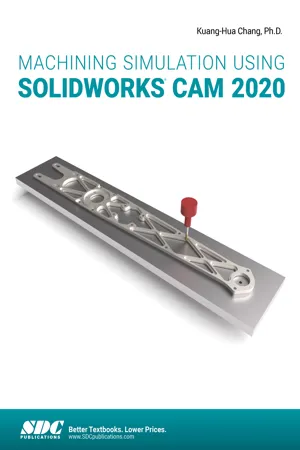
- English
- PDF
- Available on iOS & Android
Machining Simulation Using SOLIDWORKS CAM 2020
About This Book
- Teaches you how to prevent problems, reduce manufacturing costs, shorten production time, and improve estimating
- Covers the core concepts and most frequently used commands in SOLIDWORKS CAM
- Designed for users new to SOLIDWORKS CAM with basic knowledge of manufacturing processes
- Incorporates cutter location data verification by reviewing the generated G-codes
- Includes a chapter on third-party CAM Modules
This book will teach you all the important concepts and steps used to conduct machining simulations using SOLIDWORKS CAM. SOLIDWORKS CAM is a parametric, feature-based machining simulation software offered as an add-in to SOLIDWORKS. It integrates design and manufacturing in one application, connecting design and manufacturing teams through a common software tool that facilitates product design using 3D solid models. By carrying out machining simulation, the machining process can be defined and verified early in the product design stage. Some, if not all, of the less desirable design features of part manufacturing can be detected and addressed while the product design is still being finalized. In addition, machining-related problems can be detected and eliminated before mounting a stock on a CNC machine, and manufacturing cost can be estimated using the machining time estimated in the machining simulation.
This book is intentionally kept simple. It's written to help you become familiar with the practical applications of conducting machining simulations in SOLIDWORKS CAM. This book provides you with the basic concepts and steps needed to use the software, as well as a discussion of the G-codes generated. After completing this book, you should have a clear understanding of how to use SOLIDWORKS CAM for machining simulations and should be able to apply this knowledge to carry out machining assignments on your own product designs.
In order to provide you with a more comprehensive understanding of machining simulations, the book discusses NC (numerical control) part programming and verification, as well as introduces applications that involve bringing the G-code post processed by SOLIDWORKS CAM to a HAAS CNC mill and lathe to physically cut parts. This book points out important, practical factors when transitioning from virtual to physical machining. Since the machining capabilities offered in the 2020 version of SOLIDWORKS CAM are somewhat limited, this book introduces third-party CAM modules that are seamlessly integrated into SOLIDWORKS, including CAMWorks, HSMWorks, and Mastercam for SOLIDWORKS.
This book covers basic concepts, frequently used commands and options required for you to advance from a novice to an intermediate level SOLIDWORKS CAM user. Basic concepts and commands introduced include extracting machinable features (such as 2.5 axis features), selecting a machine and cutting tools, defining machining parameters (such as feed rate, spindle speed, depth of cut, and so on), generating and simulating toolpaths, and post processing CL data to output G-code for support of physical machining. The concepts and commands are introduced in a tutorial style presentation using simple but realistic examples. Both milling and turning operations are included.
One of the unique features of this book is the incorporation of the CL data verification by reviewing the G-code generated from the toolpaths. This helps you understand how the G-code is generated by using the respective post processors, which is an important step and an excellent way to confirm that the toolpaths and G-code generated are accurate and useful.
Who is this book for?
This book should serve well for self-learners. A self-learner should have basic physics and mathematics background, preferably a bachelor or associate degree in science or engineering. We assume that you are familiar with basic manufacturing processes, especially milling and turning. And certainly, we expect that you are familiar with SOLIDWORKS part and assembly modes. A self-learner should be able to complete the fourteen lessons of this book in about fifty hours.
This book also serves well for class instruction. Most likely, it will be used as a supplemental reference for courses like CNC Machining, Design and Manufacturing, Computer-Aided Manufacturing, or Computer-Integrated Manufacturing. This book should cover five to six weeks of class instruction, depending on the course arrangement and the technical background of the students.
Frequently asked questions
Information
Table of contents
- Title Page
- Copyright
- Preface
- Acknowledgements
- Table of Contents
- Lesson 1: Introduction to SOLIDWORKS CAM
- Lesson 2: NC Part Programming
- Lesson 3: SOLIDWORKS CAM NC Editor
- Lesson 4: A Quick Run-Through
- Lesson 5: Machining 2.5 Axis Features
- Lesson 6: Machining a Freeform Surface and Limitations
- Lesson 7: Multipart Machining
- Lesson 8: Multiplane Machining
- Lesson 9: Tolerance-Based Machining
- Lesson 10: Turning a Stepped Bar
- Lesson 11: Turning a Stub Shaft
- Lesson 12: Machining a Robotic
- Lesson 13: Turning a Scaled
- Lesson 14: Third-Party CAM Modules
- Appendix A: Machinable Features
- Appendix B: Machining Operations
- Appendix C: Alphabetical Address Codes
- Appendix D: Preparatory Functions
- Appendix E: Machine Functions